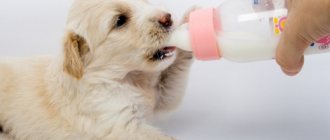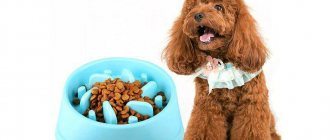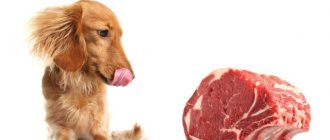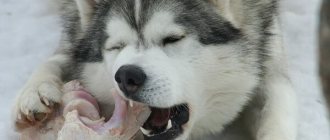Features and rules for creating a diet for a puppy
Nutrition for a puppy is the basis for the structure and formation of the body. In the first month of life, the dog just learns to eat and drink from a bowl on its own. Without lifting it from the breast, they begin to feed the pet. Complementary foods are usually chosen by the breeder. This can be industrial pastes and pates for small puppies or dairy products (milk diluted with water, homemade kefir), low-fat broths.
In the first two months, the basis of the puppy’s diet is dairy and fermented milk products (approximately 50% of the menu). Feeding with meat broths, minced meat, small amounts of cereals and vegetables is allowed. By 3-4 months, the dose of protein increases, about 50-70% of the diet (eggs, lean meat, sea fish).
We make a sample menu for the puppy for the day
Of course, the diet and menu directly depend on age. This is reflected not only in the ingredients, but also in the number of meals.
Feeding patterns and plans are always approximate and should not be built specifically from these ingredients. You can experiment, the main thing is to maintain the proportions of nutrients.
To create a menu for a 1-2 month old puppy, it is worth remembering that 50% of the diet is dairy products, 35% protein and 15% grains and vegetables:
- First meal (7:00) – oatmeal cooked in diluted milk;
- Second (10:00) – buckwheat or rice in meat broth with small pieces of chicken or beef;
- Third (13:00) – dairy products (low-fat cottage cheese, kefir, yogurt);
- Fourth (16:00) – cereal with beef or chicken (with the addition of vegetables);
- Fifth (19:00) – dairy products;
- Sixth (22:00) – raw protein (meat, fish).
As you grow older, the volume of dairy products decreases and is replaced by meat, offal, and fish. Also, by the age of one year, the puppy should be switched to two meals a day. To do this, every 2-3 months the interval between meals increases.
What foods should not be given?
There are a number of foods that are undesirable for consumption by a puppy, or even a dog of any age, for example:
- potato;
- tomatoes;
- melon;
- popcorn;
- legumes;
- cabbage;
- grape;
- fatty cottage cheese and kefir.
In addition, eating what you feed dogs is strictly prohibited. First of all, these are bones. It is absolutely not recommended to give them to a puppy, especially tubular ones (chicken and turkey) and fish ones. They split and can cause injury to the internal digestive organs.
You can make broth from the bones, which is added to porridge for aroma and taste.
From 4-5 months, it is allowed to eat raw beef bones (shanks) to form a bite and clean teeth from plaque. The pet will not be able to chew them, but it will give the jaw a good workout.
It is also prohibited to give dogs of any age pork, butter, sweet and flour products, fried foods, sauces, salt, and sugar. Puppies over 8 months old should not be given milk.
Popular questions about puppy nutrition
After a pet gets into a new home, its owner has a lot of questions, many of which relate to nutrition. It is advisable to decide on the answers to them in advance in order to prepare everything necessary and not cause harm to the puppy. Let's look at the most popular ones.
At what age should you start feeding?
You need to start feeding them from the age of 12 weeks. Not earlier!
For this, most often, cow's milk is used, which is heated to 30 degrees and a little powder is added (1 cup/1 tablespoon). But cow's milk is used because of its availability.
The best option would be to feed with goat or sheep milk, since their composition is closest to that of a dog.
Can I feed it adult food?
No, because puppies need almost double the norm of all substances and vitamins. Food for an adult dog will not provide such needs. Special food is required, it contains an increased amount of protein (25-30%), added fat and water-soluble vitamins, minerals and other substances.
In addition, you should not feed your baby cat food. It contains taurine, which cats need. The dog’s body synthesizes it on its own. Additional intake can lead to heart failure.
Can I feed my puppy baby food?
No, if we are talking about complete nutrition for a small dog. Baby food should only be given as an occasional treat when it comes to pureed meat.
It is impossible to transfer your baby to feeding infant formula, since it contains a lot of sugar and is intended primarily for human children. But the gastrointestinal tracts of humans and dogs are very different, and such a mixture can cause allergies, stomach upset and diarrhea.
Should I feed at night?
The answer to the question depends on age. If the baby is less than two months old, then it is worth feeding him at night if he wakes up and shows restlessness. However, from the age of 2-3 months, night feedings should be abolished.
When to switch to two meals a day?
The dog should eat twice a day, starting from the moment it turns one year old. From the age of 6 months until this point, the puppy is transferred to three meals a day.
Is it possible to feed a puppy before vaccination?
It is better to refuse feeding before vaccination. You need to plan your trip to the doctor so that you can visit him in the first half of the day. However, water must be given in unlimited quantities.
How to feed a newborn puppy without a mother?
The best option to feed a newborn puppy who is left without a mother is to find another nursing bitch.
It must be a nursing dog with a small litter of puppies and a suitable breed size. In real conditions, this is very difficult to do.
Then you will have to feed them artificially, but you should understand that this is a very labor-intensive and responsible process. The life of a small dog depends on it.
A specialized mixture is used - a substitute for bitch's milk. Feeding is carried out every 2-3 hours, food temperature is 35-40 degrees.
What to feed a sick puppy?
If signs of any disease appear, you should immediately visit a veterinarian. The veterinarian will prescribe treatment and diet.
First aid for diarrhea is a starvation diet. It is unknown what causes diarrhea, so it is better not to feed the puppy until you visit the veterinarian.
How to feed if you work?
The main rule of feeding a small pet is regularity. If it is impossible to be with your baby all day and provide regular feeding, you will have to look for additional options.
You can ask someone they know or neighbors to provide such care. In addition, there are special automatic feeders that can be programmed to dispense a portion of food at a certain time.
It will be necessary to accustom the dog to the feeder so that in your absence he understands where he will eat. In this case, the owner has no choice - feeding will be carried out with dry food. In any case, additional financial expenses will be required in such a situation.
Photo: pixabay.com
How much and how to feed
There are certain norms and rules regarding the amount of food for a puppy and the feeding process: when, how many times a day, according to what principle. In order for the puppy to develop correctly, not overeat, and not gain excess weight, it is important to adhere to them:
- Dogs are fed several times a day, and the younger the pet , the more often he needs to be given food (relative to puppies up to a year old), after the 1st year the number of meals is standardized and reduced to 1-2 times a day; feeding times should be the same every day;
- In terms of time, the pet should invest 10-15 minutes, without prolonging the process; otherwise, the bowl is taken away, so the puppy will learn to eat food measuredly, but not slowly;
- In case of refusal to eat or malnutrition, the portion is hidden in the refrigerator until the next time; there is no need to increase or decrease the volume;
- Food temperature – room temperature, consistency – semi-liquid (like sour cream);
- Your pet should not overeat ; you should adhere to the norms prescribed for age, breed and weight; feeding from the table is strictly prohibited; treats are purchased at pet stores or prepared separately; bones are prohibited;
- You need to stick to one type of food (dry or natural), without mixing them; a transition is possible if something does not suit the owner or the dog;
- The diet should include all recommended microelements (proteins, fats, carbohydrates, vitamins, minerals), so it should not consist only of cereals or meat, you cannot replace one element with another (instead of protein, add a portion of fat);
- If you refuse a product (kefir, cottage cheese), there is no need to force the puppy; you can replace it with something of equal value;
- Food is not salted or seasoned;
- In order for the skeleton of a large puppy to form correctly, when feeding you need to use bowls on stands , thanks to them the dog will not slouch;
- Active games are allowed only 1-2 hours after eating ;
- All feedings are carried out only after walks;
- It is important to constantly have clean water (not from the tap or boiled) in the drinking bowl;
- If the puppy is a raw foodist (eats meat raw), then the product must first be frozen and kept in the freezer for at least 3 days.
Standardly, puppies at 1-2 months are fed 6 times a day, from 2 to 3 months - 5 times, 3-4 months - 4 times, then transferred to 3 meals a day, and after 8-10 months for 2 times. However, the norms are individual for each breed; it is better to discuss them with a veterinarian or breeder.
After feeding, the dog's tummy should not be swollen or clogged. Such deformation indicates overfeeding; the serving size should be reduced.
The amount of food and serving size are calculated individually for each puppy. The required daily dose is 6-7% of the dog's weight . With a weight of 10 kg, the puppy should receive at least 600 grams of food per day.
Food options
First, you will need to decide what food to feed your dog. In Europe and the USA, numerous canned food and dry food are used; for Westerners this is commonplace. In the countries of the former USSR, dogs are fed a variety of foods, from soups to cereals. Perhaps the personal preferences of the owners, who try to feed their pets with foods similar to human ones, are to blame for creating the menu.
Often they simply do not trust dry food, considering it pampering and frivolous food. When switching to dry food, a reflex is often triggered - there is not enough food in the bowl. A larger portion is added, which seriously harms the dog’s stomach. Dry food expands, putting strong pressure on the walls of the stomach and intestines, causing pain and discomfort. Dogs are unable to stop eating food and digestive problems occur. The choice of food remains with the owner.
Natural food, however, is not always uniquely healthy and nutritious. Veterinarians are inclined to believe that soups, in addition to those with the addition of potatoes, have a serious negative impact on the health of your shaggy friend. Particularly heated debates arise when it comes to feeding dogs meat.
Most veterinarians believe that it is better to feed dogs beef, and not prime beef. Rabbit, horse meat and lamb are suitable, there is some debate about the latter, the product is fatty. The meat is given raw, after freezing the piece. There is a caution associated with the possible presence of worms in the meat.
It can be difficult to choose the type of feed. To decide which dog food is best to buy, you will need to understand the pros and cons of different types of dog food. There are different types of dog feeding: dry, wet and mixed. Which one the dog prefers is a matter of practice. The dry type of feeding has become widespread and beloved by owners of four-legged pets. However, there are many advantages and disadvantages in the mixtures.
Feeding dry food
If a breeder decides to switch a pet to dry food, a procedure for switching to this type of food and compliance with feeding characteristics is required. The dog’s stomach and digestion will not withstand the sudden transition, and the pet will begin to experience serious problems in the body. How to feed dry food to a puppy:
- Dry food is selected of high quality, premium grade. The following foods are recognized as the best dry food for puppies: Dog Chow, Pro Plan, Yakanuba, Pro Pak, Hills and others.
- If you start feeding your puppy dry food, it is better to remove other foods from the diet, otherwise mixing food will lead to indigestion.
- Dry food must be exactly appropriate for the baby’s age.
- Dry food does not replace natural nutrition; with dry feeding, the puppy is offered an additional vitamin and mineral complex.
You should switch to food gradually, over about a week.
It will be necessary to separate the food and porridge in accordance with the proportions, from a larger proportion of porridge to a larger proportion of feed. You should not overfeed your dog; it is better to give dry food in portions. There is always water next to the bowl to quench your thirst. Pet stores have a huge selection of dry food, but does your pet need formula? According to research, they are needed, but in a certain quantity. Dry food from most manufacturers contains trace minerals and vitamins. The components must be present in the animal’s body in the proper quantities, otherwise troubles with the fur are inevitable.
When choosing what to feed your dog at the pet store, pay attention to the composition of the food. The packaging requires a listing of microelements and vitamins contained in the granules. A growing body requires a lot of calcium and vitamins B and D. This is the basis for strong bones and beautiful coat. If the pet is already an adult, focus on vitamin A, E, and calcium. Metal ensures the indestructibility of the dog's health; the lack of the element is reflected in the body systems.
Dry food can cause constipation; do not put excess in your pet's bowl. The daily portion should not exceed 150 grams for a small dog such as a Pekingese or Beagle. A large dog is given up to 300 grams of food.
Advantages:
- Relatively low cost;
- Ease of use;
- Duration of storage;
- Dry food is healthier for your dog's teeth than wet food;
- There is no need to prepare your dog's food;
With the listed advantages, remember that even the best dry dog food has disadvantages: an inflated amount of preservatives and flavorings is often added to the granules; manufacturers are able to replace natural meat with low-quality waste from meat production and offal. The best dog foods are produced taking into account the needs and according to age, health status, and breed.
What is included in the feeds that confidently occupy a leading position in the ranking of quality feeds:
- Meat. The meat content in high-quality natural dog food is at least 50%. Replacing meat with offal significantly reduces the nutritional value of feed, making products cheaper. The absorption of feed, where meat is replaced with by-products or plant analogues, is significantly lower. If you decide to save on cost, you risk spending much more on treating your pet for intestinal disorders. Natural meat is considered the only truly healthy product, a source of protein.
- Vegetables. In nature, this rare predator feeds on vegetables. When kept at home, dogs do not have access to wild herbs that wild animals eat. The content of plant components in feed is elevated to the rank of mandatory. The amount of vegetables in high-quality feed does not exceed 50%. Most often, carrots and potatoes are included in the feed, and a little less often cabbage and root vegetables. Vegetables play a major role in delivering vitamins and plant fiber to the dog’s body. It is preferable for dog food to contain pieces of vegetables rather than puree or powder; when cut, plants retain more useful substances.
- Cereals. Rice, millet and oats are added to dog food. The content of cereals in the feed does not exceed 5 – 7%. Cereals are a source of plant fibers that play an important role in the dog’s digestion process and accumulate carbohydrates. Ideally, the grains are placed whole, or in extreme cases, flattened, but not in the form of a crushed substance. Manufacturers of cheap feed often purchase waste from small breweries that use broken rice. These fermented rice residues are added to the pet's food mixture.
- Fats. Fats are necessary for the absorption of a number of vitamins, and adding them to dog food is important. As a rule, animal fat is used, but to reduce the cost of feed, vegetable oils can be added. In addition, used cooking oil has an attractive odor to dogs. Feed with the addition of this oil is eaten with great appetite.
When choosing suitable food for your animal, carefully study the product packaging. In addition to the production date and expiration date, pay close attention to the composition: a true quality product contains at least 50% natural meat, pieces of vegetables, whole grains, animal or vegetable fat.
Nutrition for nursing dogs
A separate topic is worth highlighting food for nursing dogs. Food for nursing dogs is sold in pet stores. A mother dog requires a rich diet. The food contains a colossal amount of calcium, magnesium, zinc, phosphorus and vitamins necessary for the bitch and offspring.
The period of pregnancy, childbirth and lactation is severe stress for a pet. During this period, it is worth paying special attention to the pregnant dog; the dog’s health and life are under serious threat. Immediately after giving birth, a dog can go without eating or drinking for several days - the body gets rid of excess substances and experiences stress. But immediately after the wounds heal and the body recovers, the appetite will be restored and doubled.
It is estimated that a dog gives ten kilograms of milk to puppies, which requires a lot of energy to produce. For the health of puppies and mothers during lactation, vitamins and minerals are required. Remain especially attentive to chemicals; try to limit the treatment of the animal by removing antibiotics and chemical medications.
Advantages of canned food for dogs
- Separation by cost - you can choose canned goods marked premium or opt for an economical option. The first contains exclusively natural high-quality meat or fish; the economy version contains by-products and vegetable substitutes;
- Increased product digestibility;
- The quality of canned food is usually much higher than that of dry food;
Among the disadvantages of canned dog food, we note a short shelf life and inconvenience of use during transportation of the animal.
When choosing the type of feeding, take into account the dog’s age, physical activity, and time of year. You can't ignore your pet's preferences. Often the dog refuses to eat high-quality, elite food, but happily eats cheap dry food. It’s worth taking food for testing in small portions and observing the animal - whichever you like best, then decide on that.
Diet for a certain age
Depending on the age of the puppy, food intake is reduced, portion size is increased, and certain foods are allowed or prohibited. Therefore, it is important to consult with a veterinarian and specialists and approve the diet so as not to harm the dog.
Nutrition for a 1 month old puppy
Usually, at this age, the dog has enough mother's milk. It happens that the female empties too early, or a large litter does not fully share the food. Experts recommend introducing early complementary feeding using liquid foods based on milk and cream.
Nutrition for a puppy at 2 months
During this period, active bone growth and system development begins. It is from 2 months that they begin to give vitamin complexes, because the puppy is transferred to semi-adult food.
Despite the significant predominance of dairy products, the dog is prohibited from drinking undiluted milk.
In addition, it is important to provide your pet with high-quality lean meat. Or choose good puppy food. The granules are soaked in water and used according to the instructions.
Puppy nutrition at 3 months
This period is characterized by the addition of fish to the diet. River fish is prohibited, especially if not thermally processed. Also, at about 3-3.5 months, puppies' teeth change. For the process to go smoothly, the dog must receive all the necessary vitamins and chew medium-hard food - carrots, apples.
Option for feeding a puppy from 1 to 3 months (table)
| Age | Number of feedings | Acceptable and predominant products | Sample menu |
| 1 month | Depending on the amount of breast milk received, complementary foods are introduced 4-5 times a day | Breast milk predominates, for example complementary feeding with quail eggs, diluted goat and cow milk, cream | Every 2-3 hours the puppy should receive complementary foods if there is not enough mother's milk; it can be ready-made factory mixtures, or prepared: 3 parts milk + 1 part cream (20%) + 2-3 quail eggs (per liter) |
| 2 months | 5-6 times a day | Fermented milk products and lean meat predominate, cereals and vegetables are included | A mixture of low-fat cottage cheese and sour cream; Rice cereal boiled in water with the addition of small pieces of lean beef; Cottage cheese mixed with grated carrots and apple; Oatmeal or buckwheat porridge with boiled vegetables and pieces of chicken; Ryazhenka or kefir; Small pieces of raw or scalded meat |
| 3 months | 4 times a day | Sea fish without bones is added to the list of allowed products, milk is completely removed from the diet | Fermented milk products with fruit (kefir with apple); Oatmeal or rice porridge with the addition of pieces of boiled fish; Cottage cheese with sour cream; Buckwheat porridge with lean beef |
From six months to a year
The period of the most intensive growth. Now there is an almost complete refusal of dairy feeding, 50% of the diet is meat and protein. Fermented milk products are included in the menu a maximum of 2 times a week. Gradually, by the age of one year, the dog is transferred to two feedings a day.
What not to feed
We have noted those products that should become the basis of a puppy’s diet. There are foods that are strictly prohibited from being included in his diet:
- sweets and sweet pastries, bread. Glucose in them will cause fermentation and problems with the gastrointestinal tract, obesity;
- salt and spices;
- tubular bones. They are dangerous due to their fragments, which can pierce the intestines;
- pork, which is a source of trichinosis, which is difficult to cure;
- cabbage and legumes;
- whole milk;
- River fish;
- raw chicken;
- boiled potatoes;
- pasta;
- sausages and anything that contains preservatives.
Photo: pixabay.com
Diet depending on breed
The difference in the nutrition of puppies of certain breeds is determined not only by size, but also by energy costs and genetic predisposition to allergies. Therefore, it is important to consult with a veterinarian and the breeder of specific individuals to determine possible eating disorders for specific foods.
Feeding small breed puppies
The nutrition of small dogs is no different from standard feeding and should include all the microelements necessary for the proper formation of all organ systems.
The most important rules when choosing food or preparing food are small granules and pieces, no too hard particles, small portions.
Puppies are taken from their mother and sold at 2.5-3 months . During this period, the breeder is already making the first baits, so the future owner will be aware of the dog’s usual menu. You should adhere to it, however, if the owner is not satisfied with the brand of food or some of the ingredients of natural food, a transfer is planned. First, the animal is fed with foods that will be provided in the future diet. If allergic reactions and disorders do not occur, you can continue implementation.
Yorkie puppy nutrition
A 2-3 month old Yorkie should eat 4-5 times a day according to a clear schedule. Even because of strong love, the puppy cannot be fed or fed additionally. The pet will not navigate in time space and will get used to begging for food. It's bad for your metabolism. The percentage of substances is standard.
Despite the fact that all puppies are quite mobile and active and grow quickly, Yorkshire terriers gain weight slowly. A standard dog weighs no more than 3 kg per year. Therefore, it is difficult to observe weight fluctuations. The breed does not suffer from obesity, but does not require additional calories. Decorative breeds do not exercise intensely, so they spend less energy.
The breed is highly allergic, so any allergenic foods should be avoided: honey, pork, tomatoes, citrus fruits, onions and garlic, sweets, exotic fruits. Also, do not overuse eggs and whole milk.
What to feed a Chihuahua puppy
The feeding scheme remains standard . Up to three months, the puppy is fed 6 times a day, then the number of meals is gradually reduced. Like Yorkshire Terriers, Chihuahuas do not require large portions or high calorie intake. They grow slowly and gain weight due to the specificity of standard sizes.
Up to 6 months, a puppy needs 20-30 grams of food per day, from 6 to 12 – 40 grams. Then the volume is calculated using the usual formula (6-7% of the puppy’s weight).
Foods that should not be in the Chihuahua's diet: sweet, fatty and fried foods, bell peppers, rabbit, lamb, pork, horse meat, rutabaga, radishes, cabbage.
Nutrition for Dachshund puppies
Nutrition for this breed is selected only individually. Dachshunds, for the most part, are not picky, but some already have developed food preferences by the age of 2-3 months. For example, some puppies cannot tolerate processed foods.
Dachshunds are very active, which is due to their genetic functionality. Hunting dogs require more food, so for them the calculation is based on the formula 40 grams per 1 kg of weight. Proteins should predominate in the feed (after 3 months). It is important to provide Dachshunds with fluoride and calcium to ensure their unusual bodies develop properly.
It is not recommended to include chicken, pork and lamb in the diet. Prohibited products do not change.
Feeding medium breed puppies
Medium-sized breeds are most often hunting. In terms of weight and amount of food, they need the most food because there is a high loss of energy. For all age differences, there are separate lines of dry food that are easy to use - according to the instructions. The natural diet pattern remains virtually unchanged.
What to feed a Spitz puppy
A special feature of feeding Spitz is the lack of milk in the diet. This is one of the breeds that is not allowed whole milk even as a puppy. In addition, the presence of zinc, which is responsible for the formation of the coat, is important for Spitz dogs.
A dog, like all decorative animals, does not require increased nutrition. The feeding scheme is standard. A complete transition to the predominance of meat products is made in 4-5 months.
Feeding a Spaniel puppy
As for the nutrition of spaniels, experts come to a common opinion - monotony is good for both the owner and the dog. The fact is that Spaniels have allergies and quickly gain weight. It is important for them to develop a single menu and stick to it throughout their lives. These animals are not picky, their body will be grateful.
French Bulldog puppy diet
These dogs are considered the descendants of fighters, strong and muscular. But for proper muscle formation, training alone is not enough. It is important to provide your pet with the proper amount of protein. To do this, either dry food with a high level of protein mass is selected, or a menu is developed based on lean meat.
This particular breed benefits from being given raw scalded beef bones to build the correct bite and develop the jaws.
Feeding large breed puppies
There is a myth that the larger the dog, the harder it is to feed it, because it requires more meat, more food. You can talk about this topic for a long time. In fact, based on the formula, large dogs actually need more food, which is determined by their size and physical expenditure. In addition, pets living in enclosures or just in yards will need even more food. On the other hand, large, often giant, animals are transferred to one-time feeding.
What to feed a German Shepherd puppy
The breed is large and strong, so a special volume scheme is proposed for feeding it. At the age of 1-2 months, the shepherd dog should receive approximately 1 glass of food, divided into 6 meals. At 2-3 months the volume increases by 1 glass. Up to 6 months, the animal should eat 1 liter of food, from 6 to 12 months - 1.5 liters.
The predominance of meat products on the menu is a must. A shepherd dog should not eat cereals, bread or vegetables alone. It is possible to switch to fish, but not earlier than from 3 months.
Read a detailed article on this topic: “Review of dry food that is suitable for feeding German Shepherd puppies.”
What to feed a Husky puppy
Huskies are completely picky and do not have any special dietary guidelines. Their development is rapid, so by the age of 8 months they try to switch them to 2 meals a day. Puppies cannot have milk from the 1st month, but this does not mean that dogs do not need fermented milk products.
Labrador puppy nutrition
Labradors are dogs prone to obesity and rapid weight gain. Due to the habitual keeping in urban conditions for humans, the animal does not have the opportunity to spend as many calories as it should be consumed according to the schedule. Therefore, the calculation of serving volume should be individual, especially for large breeds.
Like any dogs, Labradors are prohibited from bones, allergenic foods, and food from the owner’s table. The meal plan does not change. They recommend 2 meals a day for an adult. At 2-3 months, the number of meals remains unchanged - 5 times a day.
Find more detailed information in the article: “How to feed Labradors correctly: menu, types of food, nutrition for puppies.”
Features of nutrition for Laika puppies
The breeds of this group are characterized by low appetite and small needs; they are accustomed to working long and hard without receiving food. Historically, Laikas obtained their own food, and were hardened in the conditions of the cold north. Puppies are fed according to the standard plan, but if the pet does not want to eat or does not finish eating, then the volumes or meals should be reduced.
The diet of these dogs should consist of meat and fish products, offal and foods rich in healthy fats.
Prohibited Products
Let's name 100% prohibited products. Eating products from the list by dogs will inevitably lead to numerous difficulties with the health of their four-legged friend and shorten their lifespan. Harmful to dogs:
- Fatty meats, for example, pork or liver, yogurts;
- Fruits and vegetables with high glucose content;
- Milk and nuts, the dog's stomach is not able to digest the position;
- Tubular bones that can damage the stomach and intestines;
- Flour products that contribute to the development of diabetes.
We should also talk about forbidden foods. Owners, wanting to pamper their pets, sometimes give their dogs unauthorized and harmful things. This includes all types of seasonings, smoked meats, and bread. A banal loaf of bread can cause diseases of the gastrointestinal tract and other organs. You can’t pamper your pets with fried or smoked foods. Chicken skin containing excess fat is harmful.
Restrictions also apply to dry food. Low-quality dry food will cause much more harm than a fried piece of pork. Veterinarians rightly note that it is necessary to take high-quality, expensive food. However, you should not make sudden transitions from cheap to elite food. Even as a gift, pouring unfamiliar food into a bowl means putting the dog’s body in danger. The delicate gastric organization is easily disturbed not by the best or the worst, but simply by another food.
You should not get carried away with feeding fish; the substances it contains do not have a very good effect on the dog, and river fish, full of bones, can easily damage internal organs. An important point is the age of the dog. What is healthy and tasty for young puppies is not always healthy and tasty for older dogs. The diet is distributed with age, young people need more energy and calories for games and running around, sedate dogs are unlikely to want to do this.
Vitamins and mineral supplements in the diet
Dry food contains minerals and vitamins, but with a natural diet, the puppy will need additional microelements. There are special veterinary vitamin complexes in the form of tablets or dry powders that are mixed with food. One of the most popular is Nutri-Vet Puppy-Vite, intended for puppies under 9 months.
Natural supplements you can use:
- Crushed or granulated chalk;
- Eggshells (ground into powder);
- A teaspoon a day of fish oil;
- A teaspoon of honey per day in porridge (be careful, this product is a strong allergen, consultation with a specialist is required);
- Brewer's yeast;
- From 2-3 months they give beef trachea and cartilage.
Puppies of all breeds should receive vitamins A and D-2 daily in drops (depending on the size, a dose of 1-2 drops is prescribed); calcium tablets 1-3; phytin tablets 1-3.
Vitamins
As a dietary supplement, natural-fed puppies should be given vitamins for general strengthening of the body. Their norm is determined depending on age and breed. But even if the owner took a mongrel puppy, he needs useful supplements no less than a purebred representative.
Among the vitamins recommended for growing dogs, A and D are the leaders, especially in the autumn and winter seasons. They contribute to the normal development of the musculoskeletal system and the prevention of rickets.
Expert opinion
Anna Abramenko
An avid dog lover. Experience in veterinary medicine since 2009.
Ask a Question
If puppies eat dry food, they do not need extra vitamins. In this case, additional substances will only harm him.
Feeding puppies dry food
Dry food is usually pre-selected by the breeder who sells the puppies. He recommends a proven brand that was given to the puppy before sale. They start feeding dry foods only from 2.5-3 months, choosing super-premium food for small puppies . Their specificity is hypoallergenicity and small granules. It is recommended to further soften the granules with water.
How much to give a puppy this or that food is indicated in the instructions on the package.
Genetic characteristics of the health of mongrels
Every potential owner who decides to get a mongrel dog agrees to a kind of “lottery”. The main advantage is the genetic characteristics of the health of mongrels, but this does not mean that outbred dogs do not get sick or can get by with poor quality nutrition. Potentially, mongrel dogs are healthier, smarter and more comfortable because they instinctively adapt to their owner's needs.
The diet for a dog should be compiled as individually as possible, since outbred dogs can inherit the not very “successful” genes of some ancestors.
The statements below are myths and are spread by illiterate people:
- Mongrels are omnivores - no, for a mongrel dog you need to select the appropriate diet.
- Mutts can be fed table scraps - absolutely not, since the dog's genetic inclinations are unknown.
- Mutts do not need to be bathed - they do, but not often. They also need to be combed, and wire-haired dogs need to be trimmed.
- Mutts have strong immunity and do not need to be vaccinated - the immunity of mongrel dogs is indeed stronger than that of mongrel dogs, but it is not a competitor to deadly viruses.
- Worms and fleas in a mongrel can be treated with folk remedies - it is possible, but is it necessary? Folk remedies can be toxic not only to parasites, but also to the pet. Questionable savings can lead to tragic losses.
Statistics reveal a number of facts about the health of mongrel dogs:
- Short-haired mongrels are more likely to suffer from plant protein allergies.
- Long-haired dogs are prone to skin problems.
- Mutts age later, but develop earlier.
- In old age, mongrel dogs are less likely to have dental problems.
- At the age of 3 years and older, mongrel dogs are prone to gaining excess weight.
When preparing a diet for a mongrel dog, you need to take into account its past. It is important not only to choose a high-quality diet, but also to correctly calculate the daily food intake. Practice shows that dogs that were once hungry are prone to overeating, even when they are pets and not deprived of anything.
Water in the diet
As long as the puppy feeds on its mother's milk, it is not at risk of dehydration. After weaning, this condition may occur within 1-2 hours . Therefore, in the first months, the animal must be mixed with diluted bitch milk extract during dry feeding. With natural feeding this is not required.
Without enough fluid, puppies' blood thickens, which leads to oxygen starvation and metabolic disorders. You can give additional water using a syringe without a needle or syringe.
A dog is not a trash container. She should not eat table scraps. A puppy, as a young and developing organism, must receive all the necessary microelements in the best quality products. Otherwise, his health will be threatened by viruses, infections and pathological diseases.
4.4 / 5 ( 11 votes)
Frequency of feedings per day
Puppies need a specific number of meals based on their age. The smaller the baby, the more food he needs. When the puppy is about a month old, he is allowed to feed himself, gradually moving from milk to regular food.
You can get acquainted with the approximate plan using the following table:
| Puppy age, months | Number of meals per day | Feeding schedule, hours |
| 1-2 | 5-6 | 7, 10, 13, 16, 19, 22 |
| 2-4 | 4-5 | 7, 10, 14, 18, 22 |
| 4-6 | 3-4 | 7, 12, 17, 22 |
| 6-10 | 3 | 7, 14, 21 |
| 10-12 | 2 | 7-20 |
From night until morning, the puppy should have a break in food. At this time of day, his gastrointestinal tract should not be loaded with food, so it is better not to feed the baby, even if he begins to whine and howl. And so that the pet does not cry from hunger, he needs to be given hearty milk porridge or meat at night.
Expert opinion
Anna Abramenko
An avid dog lover. Experience in veterinary medicine since 2009.
Ask a Question
If one day the owner violated the schedule and missed one feeding of the puppy, there is no need to treat him with a double portion next time.
Photo gallery
Photo 1. Premium Brit food for puppies
Photo 2. Royal Canin super premium puppy food
Photo 2. Super-premium food for Acana puppies
Choosing a place and utensils for feeding
The feeding location will depend on where the dog lives. However, in any case it should be:
- separate;
- secluded;
- permanent;
- away from the resting place;
- easily accessible for dog and owner;
- amenable to quick and easy cleaning;
- If you plan to keep the dog on a chain, then the feeding area is arranged so that the chain cannot turn over bowls of food and water.
If the dog's resting place is in the kennel, then the feeding place should be to the side.
When keeping an enclosure, the dog should be fed in a place other than where the animal will rest (as a rule, the enclosure should have two rooms).
The choice of dishes for dogs is not great. The bowl should be:
- metal (from food metal);
- heavy (it should not move or jump while eating);
- easy to clean (this is a daily procedure).
When choosing a mongrel puppy, you cannot predict the size and appetites of an adult dog. Therefore, initially you can feed from any metal bowl with a volume of 1 liter.
What a puppy shouldn't eat
The dog must receive all the necessary vitamins and minerals from its food. It is important to know what a puppy should not eat and what natural foods can harm him:
- It is strictly forbidden to give bones (animals, birds or fish), as this can lead to intestinal obstruction or cause rupture of the digestive organs.
- Do not give sweets, sugar and sweetener. Their entry into the dog’s body can provoke vomiting, weakness, loss of strength, and liver failure.
- Coffee, tea, and chocolate pose a threat to the heart and nervous system.
- Broccoli in large quantities is also toxic.
- Alcoholic drinks under no circumstances - perhaps no explanation is needed here.
- Citrus fruits, berries (grapes), plums, peaches, and persimmons can harm your pet's liver and kidneys due to their acids and toxins.
- Mushrooms contain toxins that are harmful to the digestive system.
- Yeast dough is dangerous due to bloating.
- The fat remaining after frying is very dangerous.
- Nutmeg negatively affects most muscles and organs.
How to care for a small puppy
Nowadays, puppies are sold, as a rule, at the age of over 1.5 months, because at 1.5 months the first vaccination is given, and the puppy is quite ready for independent life without the danger of getting sick. But if you bought a puppy at the age of one month, then it’s okay, here again the USSR comes to mind, when all the puppies were sold at the age of one month, and nothing happened, somehow they managed.
First of all, when you adopt a puppy, you need to make sure that he is healthy and has no worms or fleas.
It’s easy to make sure that your puppy doesn’t have fleas; you just need to part the fur and look.
If your puppy has fleas, you need to get rid of them, as they are carriers of worm eggs, and removing worms when the puppy has fleas is not very smart. There are difficulties in removing fleas from a 1 month old puppy,
since it is impossible to treat such a small puppy with most modern medications. The best remedy is to bathe him in a special shampoo for puppies, from some good Western company.
It’s easier with worms, if you trust the breeder and are sure that he drove the worms away, then good, but if you have even the slightest doubt about this, then it’s better to do it yourself.
“Pyrantel” in suspension from a regular human pharmacy is perfect for this purpose. You need to weigh the puppy, then buy a small two-cc or insulin syringe and measure 0.1 ml of Pirantel suspension per 1 kg of the puppy’s weight, you will get literally a couple of drops, this is enough for worms, if any. “Pirantel” was created for small children and is practically harmless, moreover, for the cost of one tablet of a dog dewormer, for example, from, you can drive away worms with “Pirantel” for several dozen puppies.









